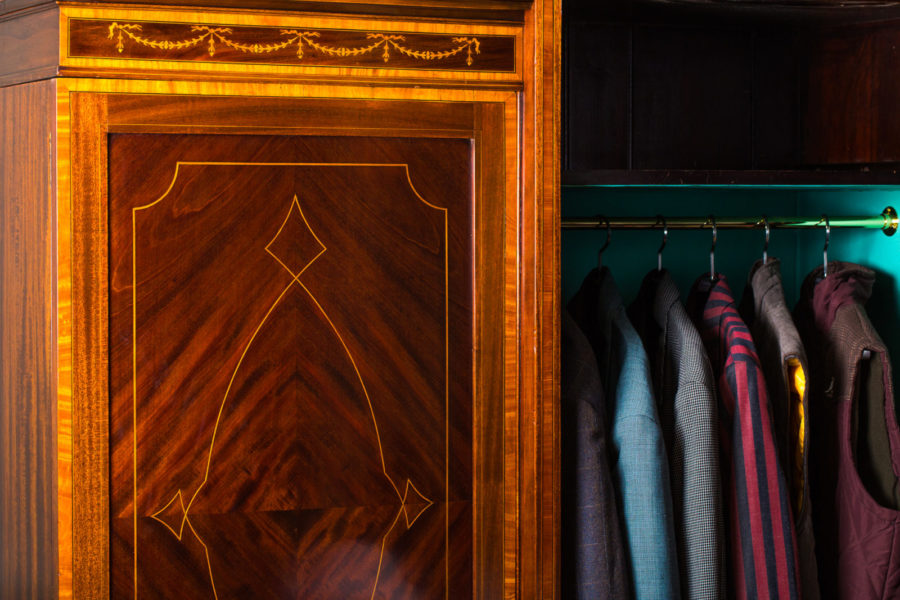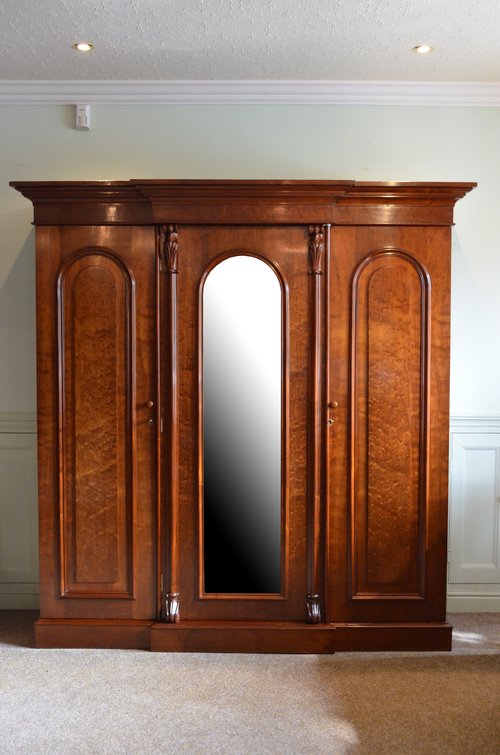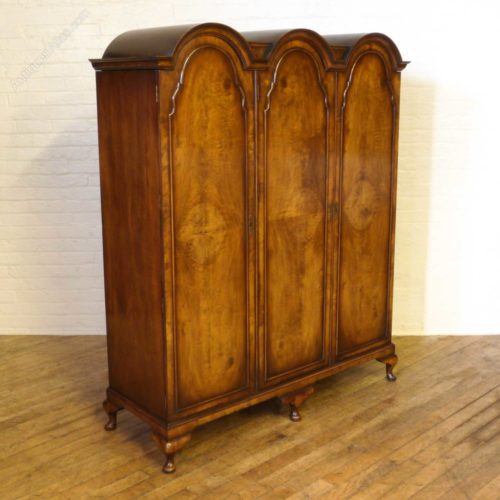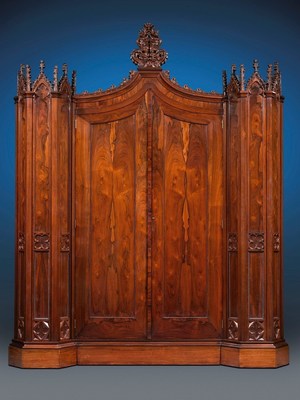
Wardrobes are something that most of us come across on a daily basis, though we probably never give them the time of day. Unless you’re C.S Lewis of course! In this article we will shed some light on their history and provide some useful tips for determining the age of your piece, and whether it is, in fact, an antique wardrobe.
In households of the past, they had a room for every occasion and activity. As time went on, the need for such an abundance of rooms decreased, but some of their names stayed on, demoted to describing mere objects. Oh how the mighty have fallen!
Much like the closet, which according to Mark Girouard ‘had a long and honorable history before descending to final ignominy as a large cupboard,’ the word wardrobe came to mean many things throughout history, prior to describing a piece of furniture to store clothes in, as we know it to mean today. Originally it was the name for a room where clothes were stored – you see the connection. Next it become a dressing room, a sleeping room, a privy according to George Chaucer, and finally by the 17th century, a piece of furniture. History tried to demote the word further by defining it as the contents of the wardrobe, though it stood its ground, literally, as a piece of furniture. Though using the term to describe ones clothes has gone out of fashion, the desire to own a wardrobe certainly hasn’t; In fact it’s more popular than ever: With antique wardrobes serving a dual purpose, being both decorative and functional, they sit pride of place in people’s homes today.
An unrivalled selection of antique wardrobes for sale.
I must add at this point that the word armoire, originally used to describe a room to store armor in (we see the etymological pattern again), has not much differentiation to a wardrobe, except that they tend to be slightly larger and more decorative. Therefore, for the sake of argument, in this article we will be referring to all forms, as wardrobes.
 Victorian wardrobe c1860
Victorian wardrobe c1860
Before we go into more detail regarding specific styles throughout history, let’s look at some factors that will point you in the right direction of a wardrobe’s age, and help you make sure it is indeed an antique. Remember anything over 100 years old is an antique.
Joinery: In 1860 furniture began to be machine cut, so any saw marks, either in straight lines or arc shapes, indicate that the piece was made after this date. Anything prior to that was handcrafted, so generally features more detailed carving and intricate designs using marquetry, parquetry, gilding or inlays. Hand cut pieces may not be perfectly symmetrical or smooth to the touch – you may even be able to see nicks or cuts from the tools.
The finish: Varnish and lacquer were used from the mid 1800s, prior to which shellac was the only finish available for furniture surfaces. Really old pieces may even use oil, wax or milk paint.
Type of wood: Antique wardrobes tend to be made out of several kinds of wood, with a cheaper one being used for the parts not on display, such as the bottom and back. For the areas on show, oak was preferred prior to the 1700s, when they started using mahogany and walnut. At the start of the 1800s rosewood also became popular and once machines were at work by 1860, pine wood was favoured for such jobs.
Signs of ageing: Wood shrinks across the grain as it ages, often resulting in warped or wonky wood and cracks. It also darkens with age and exposure, so there may be a difference in the colour in certain places that have seen varying amounts of light. These are all sure signs of an antique piece.
Oxidation: Oxidation is a sign of ageing and appears on hinges, knobs and handles as a greenish discolouration, known as patina. The surrounding wood will also darken.
Nuts and Bolts: Screws were handmade until about 1880 when machines took over. Handmade screws may have little or no taper, misaligned slots on the head and a much shallower spiral. If it has only a few dovetail joints, with pins narrower than the dovetails, then the joint was made by hand.
This should give you a better idea as to the age and authenticity of your antique. If you want more information on how to spot an antique more generally, then have a look at Pamela Wiggins tips: and here’s another great source for identification clues.
Antique wardrobes serve as a great decorative piece as well as a functional place to store clothes. Their distinct and varied styles and design can greatly affect your interior design though, so you want to make sure you know your eras and what to expect for each time from each changing style.
Beginning with the Queen Anne era at the start of the 18th century, through to the end of the Edwardian era, we will look at prevalent styles in each era, which inevitably influenced furniture making. We will also draw your attention to stylistic features and characteristics popular at each point in history.
Queen Anne is a style of its own accord, characterised by elegant, delicate furniture, with curved elements, in line with people’s changing tastes. Known as the popular period style, it stretches until 1750 in some cases, even though Queen Anne died in 1714. If you want to read more about Queen Anne furniture, check out this article: http//www.thespruce.com/queen-anne-style-furniture-148838
Queen Anne wardrobes are made from lighter woods, mainly walnut, though cherry and maple were used too. They are simple and elegant in design, and often include domed roofs and curved panels.
Prominent furniture makers: Daniel Marot and Jean Barein.

Photo from Antiques Atlas
This era spanned more than a century, where furniture was influenced by several styles, in order of appearance: Baroque, Rococo, Chinoiserie and Neoclassical. What characterised all the pieces though, was their overarching ambition to echo Neo-Palladian architecture popular amongst the aristocracy, and their use of good quality materials to make sturdy furniture.
Georgian wardrobes are some of the simplest, showcasing the classic, symmetrical design. They have panelled doors, sturdy drawers and features often include breakfront dentil cornices and fluted pilasters. Mahogany took the place of walnut as the preferred wood.
Prominent furniture makers: Andrea Palladio, William Kent, Thomas Chippendale, Thomas Johnson, Mathew Darly, Robert Adam, James Stuart, George Hepplewhite, Thomas Sheraton and John Linnel, William Ince and John Mayhew.
This era sits within the Georgian timeline ( when King George III was deemed unfit to rule), so is often included in the same description. Unlike Georgian furniture before it though, It gained exotic influences from Japan, Persia, Turkey and India.
Regency wardrobes are made from the same mahogany wood and in a similar style to Georgian wardrobes, though they have more flourishments and detail in the panelling, often exotic.
Prominent furniture makers: John Nash, Thomas Hope, Morel and Hughes, William Moore and George Smith.

Regency Mahogany wardrobe c1810
This era began with a flurry of revivals: Greek, Gothic, Rococo and Renaissance, where old styles were borrowed and embellished to give them extra flair and grandeur. Towards the second half of this era, around 1870, in response to the excessive revival styles, more modern styles were born: Eastlake, Aesthetic and Arts and Crafts.
Victorian era wardrobes are the most abundant type of antique wardrobe, and also have the most variation in style and wood used: mahogany, rose, walnut and pine. Generally, they are more elaborate in style, size and design, often with ornate carvings and detail. Mirrors also became a popular feature, usually found in the middle panel of the front three doors. Around 1860 machines began to find a place in furniture making, so that could be what differentiates an older Victorian piece from a newer one. The varying styles from the start to the end of the era, from revivals to modern movements, would have hugely influenced the design of the wardrobe, the earlier pieces being elaborate and grand and the later pieces being more simple.
Prominent furniture makers: A.W.N. Pugin, William Morris and Sir Charles Lock Eastlake.
Here you can see the great difference in style of wardrobes within the Victorian era:
This Henry Clay Rosedown plantation wardrobe, made of Brazilian Rosewood was made in 1844 at the start of the Gothic revival (1845-95). The second piece was made in 1880 during the Aesthetic movement (1870-90).
 Photo courtesy of M.S. Rau Antiques.
Photo courtesy of M.S. Rau Antiques.
The Edwardian Era saw a shift away from looking back to ageing styles such as baroque, rococo and empire styles, to a fresh more modern approach, which finds its roots in Art Nouveau style furniture.
Edwardian wardrobes are lighter (in colour and weight) than Victorian pieces and are more simplistic, with less frills. They feel more modern and less excessive, though of course some pieces still have the echoes of reproductions popular in the Victorian era.
Hopefully, you now have the tools to tell you the age of your antique wardrobes or to make sure you are purchasing a genuine antique. Good luck, godspeed and remember never judge a book by its cover, but do exactly that with wardrobes.
An unrivalled selection of antique wardrobes for sale.
| Cookie | Duration | Description |
|---|---|---|
| cookielawinfo-checbox-analytics | 11 months | This cookie is set by GDPR Cookie Consent plugin. The cookie is used to store the user consent for the cookies in the category "Analytics". |
| cookielawinfo-checbox-functional | 11 months | The cookie is set by GDPR cookie consent to record the user consent for the cookies in the category "Functional". |
| cookielawinfo-checbox-others | 11 months | This cookie is set by GDPR Cookie Consent plugin. The cookie is used to store the user consent for the cookies in the category "Other. |
| cookielawinfo-checkbox-necessary | 11 months | This cookie is set by GDPR Cookie Consent plugin. The cookies is used to store the user consent for the cookies in the category "Necessary". |
| cookielawinfo-checkbox-performance | 11 months | This cookie is set by GDPR Cookie Consent plugin. The cookie is used to store the user consent for the cookies in the category "Performance". |
| viewed_cookie_policy | 11 months | The cookie is set by the GDPR Cookie Consent plugin and is used to store whether or not user has consented to the use of cookies. It does not store any personal data. |